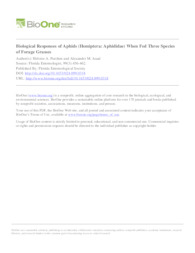Biological responses of aphids (Hemiptera: Aphididae) when fed three species of forage grasses.
Biological responses of aphids (Hemiptera: Aphididae) when fed three species of forage grasses.
Autoria: PARCHEN, H. A.; AUAD, A. M.
Resumo: In Brazil, the forage species Brachiaria spp., Pennisetum purpureum (Schumacher), and Cynodon dactylon (L.) (Poaceae) are important components in the feed that is used to rear animals for meat and milk production. Aphids are among the insects that feed on these forage species and, at high population levels, greatly reduce the amount and quality of forage. Hence, the aim of this study was to determine the nutritional suitability of the forage species Brachiaria decumbens Stapf, C. dactylon, and P. purpureum for the aphids Sipha flava (Forbes), Rhopalosiphum maidis (Fitch), Hysteroneura setariae (Thomas), and Rhopalosiphum padi (L.) (Hemiptera: Aphididae). Nymphs, which were up to 24 h old, of the 4 aphid species were observed for a biological cycle (1 full generation) on the 3 species of forage. For each association between a species of plant and a species of aphid, 70 aphids were used to create the individual units. The number of instars and the duration and survival of each instar and nymphal stage were evaluated. Additionally, the longevity and the reproductive capacity were recorded for the adults of each aphid species, and a fertility table was prepared. These parameters of each aphid species were compared for each of the 3 species of forage supplied as food and for the identical forage. All aphid species completed their development cycles and produced offspring on all 3 species of forage. However, the duration, survival, and reproduction of the aphid species changed dependent on the nutritional suitability of the forage. For all of the aphid species, the forage P. purpureum provided the best conditions for population growth. When the aphid species were fed the identical forage, R. padi developed better and produced more offspring on all forage species. The 4 aphid species have the potential to be pests of P. purpureum, B. decumbens, and C. dactylon.
Ano de publicação: 2016
Tipo de publicação: Artigo de periódico
Unidade: Embrapa Gado de Leite
Palavras-chave: Bermudagrass, Elephant grass, Nutritional suitability, Signal grass
Observações
1 - Por padrão são exibidas publicações dos últimos 20 anos. Para encontrar publicações mais antigas, configure o filtro ano de publicação, colocando o ano a partir do qual você deseja encontrar publicações. O filtro está na coluna da esquerda na busca acima.
2 - Para ler algumas publicações da Embrapa (apenas as que estão em formato ePub), é necessário ter, no celular ou computador, um desses softwares gratuitos. Sistemas Android: Google Play Livros; IOS: iBooks; Windows e Linux: software Calibre.
Acesse outras publicações
Acesse a Base de Dados da Pesquisa Agropecuária (BDPA) para consultar o acervo completo das bibliotecas da Embrapa.

